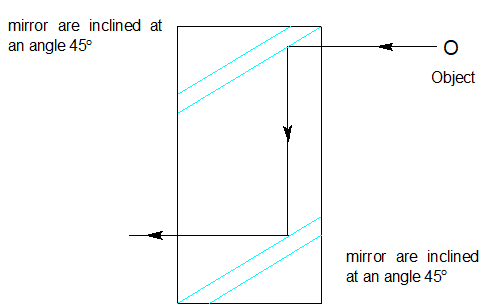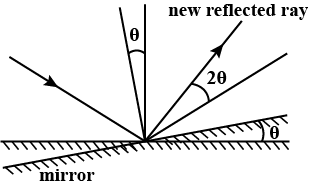
A light beam is being reflected by using two mirrors, as in a periscope used in submarines. If one of the mirrors rotates by an angle θ, the reflected light will deviate from its original path by the angle-
A. $2\theta $
B. $3\theta $
C. $\theta $
D. $4\theta $
Answer
140.1k+ views
Hint: First think about the periscope. Also think about working principles and arrangement. Then draw a picture. Now remember what the law of reflection is for the smooth plane and apply it. Check the angle of deviation from its original path.
Complete step by step solution:
First, we have to think about how the mirror is arranged. They give two mirrors arranged like periscopes. For that we need to know what is periscope? A periscope is an instrument used for looking over, around or through an obstacle or object which is prevented by a direct line of sight. The two plane mirrors in a periscope are parallel to each other inside the periscope.
Because it reflects the light rays from the upper end of the periscope to the lower end of the periscope and the reflecting surfaces of it face each other. The two planes are at an angle of ${45^0}$ with each other and with respect to the sides of the tubes. Actually, the propagation of light rays through the inner gap of the periscope becomes easier for the inclination of the plane, hindering reflections on any wrong part. Now let’s draw a picture.

Here we draw structures like periscopes. I think it’s absolutely clear to us how the mirrors are arranged in periscope. Now move to the next part. We rotate a mirror by an angle $\theta $ .
Let's draw another picture to visualize this.

Here we compare the reflection of light by rotating a mirror by an angle $\theta $ . So, try to check out the angle between two reflected lights. The ideal angle of reflection is equal to $i$. As we know in case of reflection through a plane surface reflected angle = incident angle. So the reflected angle is also equal to $i$. Then when we rotate the mirror by an angle $\theta $.
The incident angle becomes $i + \theta $ and the reflected angle is now $i - \theta $. As they are the same so we can write that the angle between two reflected light is $2\theta $. Then imagine that it will be reflected by the second mirror. But no deviation occurs there. Hence the light is deviated by an angle $2\theta $ when the mirror is rotated by $\theta $ .
Therefore option A is the correct answer.
Notes: A periscope is an instrument used for looking over, around or through an obstacle or object which is prevented by a direct line of sight. The two plane mirrors in a periscope are parallel and inclined at an angle ${45^0}$ to each other inside the periscope. For reflection of light through a smooth plane angle of incidence is the same as angle of reflection.
Complete step by step solution:
First, we have to think about how the mirror is arranged. They give two mirrors arranged like periscopes. For that we need to know what is periscope? A periscope is an instrument used for looking over, around or through an obstacle or object which is prevented by a direct line of sight. The two plane mirrors in a periscope are parallel to each other inside the periscope.
Because it reflects the light rays from the upper end of the periscope to the lower end of the periscope and the reflecting surfaces of it face each other. The two planes are at an angle of ${45^0}$ with each other and with respect to the sides of the tubes. Actually, the propagation of light rays through the inner gap of the periscope becomes easier for the inclination of the plane, hindering reflections on any wrong part. Now let’s draw a picture.

Here we draw structures like periscopes. I think it’s absolutely clear to us how the mirrors are arranged in periscope. Now move to the next part. We rotate a mirror by an angle $\theta $ .
Let's draw another picture to visualize this.

Here we compare the reflection of light by rotating a mirror by an angle $\theta $ . So, try to check out the angle between two reflected lights. The ideal angle of reflection is equal to $i$. As we know in case of reflection through a plane surface reflected angle = incident angle. So the reflected angle is also equal to $i$. Then when we rotate the mirror by an angle $\theta $.
The incident angle becomes $i + \theta $ and the reflected angle is now $i - \theta $. As they are the same so we can write that the angle between two reflected light is $2\theta $. Then imagine that it will be reflected by the second mirror. But no deviation occurs there. Hence the light is deviated by an angle $2\theta $ when the mirror is rotated by $\theta $ .
Therefore option A is the correct answer.
Notes: A periscope is an instrument used for looking over, around or through an obstacle or object which is prevented by a direct line of sight. The two plane mirrors in a periscope are parallel and inclined at an angle ${45^0}$ to each other inside the periscope. For reflection of light through a smooth plane angle of incidence is the same as angle of reflection.
Recently Updated Pages
Young's Double Slit Experiment Step by Step Derivation

Difference Between Circuit Switching and Packet Switching

Difference Between Mass and Weight

JEE Main Participating Colleges 2024 - A Complete List of Top Colleges

JEE Main Maths Paper Pattern 2025 – Marking, Sections & Tips

Sign up for JEE Main 2025 Live Classes - Vedantu

Trending doubts
JEE Main 2025 Session 2: Application Form (Out), Exam Dates (Released), Eligibility, & More

JEE Main 2025: Derivation of Equation of Trajectory in Physics

A point charge + 20mu C is at a distance 6cm directly class 12 physics JEE_Main

JEE Main Exam Marking Scheme: Detailed Breakdown of Marks and Negative Marking

Learn About Angle Of Deviation In Prism: JEE Main Physics 2025

Electric Field Due to Uniformly Charged Ring for JEE Main 2025 - Formula and Derivation

Other Pages
JEE Advanced Marks vs Ranks 2025: Understanding Category-wise Qualifying Marks and Previous Year Cut-offs

JEE Main 2025: Conversion of Galvanometer Into Ammeter And Voltmeter in Physics

Degree of Dissociation and Its Formula With Solved Example for JEE

Electric field due to uniformly charged sphere class 12 physics JEE_Main

Dual Nature of Radiation and Matter Class 12 Notes: CBSE Physics Chapter 11

Formula for number of images formed by two plane mirrors class 12 physics JEE_Main




